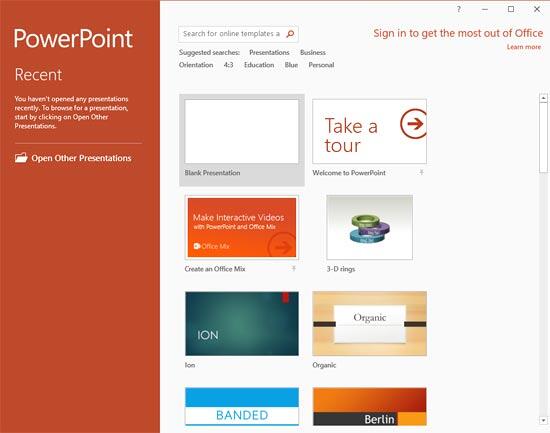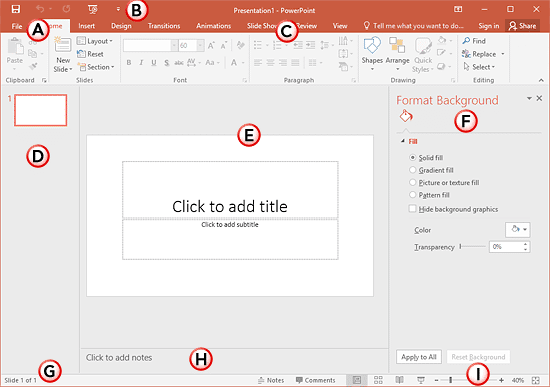Explore the interface for PowerPoint 2016 for Windows. Each interface element has a purpose and a reason.
Author: Geetesh Bajaj
Product/Version: PowerPoint 2016 for Windows
OS: Microsoft Windows 7 and higher
Here's a quick walkthrough of the PowerPoint 2016 interface, the PowerPoint 2016 interface is quite similar to PowerPoint 2013.
PowerPoint 2016 opens with a Presentation Gallery as shown in Figure 1. The Presentation Gallery provides several ways to start your next presentation using a template, a Theme, a recent presentation, a not-so-recent presentation, or even a blank presentation. Once you make choices in this Presentation Gallery, you see the actual PowerPoint interface.

Figure 1: PowerPoint 2016 Presentation Gallery
Figure 2 shows a screenshot of the PowerPoint 2016 interface, each part of the interface is explained later in this page.

Figure 2: PowerPoint 2016 interface
When you click the File menu, you see the Backstage view that contains all the creation, save, share, and print options for your presentations, as shown in Figure 3.

Figure 3: File Menu leads to the Backstage View
Is a customizable toolbar placed by default above the Ribbon, here you can add icons for your often used commands. The QAT can also be placed below the Ribbon.
The Ribbon has tabs which in turn contain groups of buttons for various options, some groups also contain galleries (for example galleries for Themes and Theme Colors).
Located on the left side of the interface, the Slides pane shows thumbnails of all the slides in the open presentation.
Displays the active slide. Learn more in our Slide Area in PowerPoint 2016 tutorial.
The Task Pane contains more options and appears when you choose an option in one of the Ribbon tabs. For example if you click the Format Background button within the Design tab of the Ribbon, the Format Background task pane opens (refer to Figure 1, shown earlier on this page).
A horizontal strip that provides information about the opened presentation like slide number, applied Theme, etc. It also includes the view and zoom options. Learn more in our Status Bar in PowerPoint 2016 tutorial. The View buttons are explained later in this page (see point I).
Right below the active slide, this is where the speaker notes are written for the current slide. Note that none of this content is visible on the actual slide while presenting, although it is visible in both Notes Page view and Presenter view. Learn more in our Notes Pane in PowerPoint 2016 tutorial.
Essentially there are three view buttons on the Status Bar displayed towards the left of the zoom-in and zoom-out options:
This toolbar is not shown in the Figure 3, shown earlier on this page, it's a semitransparent floating toolbar that spawns right next to selected text, hover the cursor upon it, and you can see the Mini Toolbar, as shown in Figure 4. And, it is also available instantly with a right-click.

Figure 4: Mini Toolbar
01 05 01 - Interface Overview: Interface in PowerPoint (Glossary Page)
Interface in PowerPoint 365 for Windows
Interface in PowerPoint 365 for Mac
Interface in PowerPoint 2019 for Windows
Interface in PowerPoint 2016 for Mac
Interface in PowerPoint 2013 for Windows
Interface in PowerPoint 2011 for Mac
Interface in PowerPoint 2010 for Windows
Interface in PowerPoint 2007 for Windows
Interface in PowerPoint 2003 and 2002 for Windows
Interface in PowerPoint for the Web
You May Also Like: In Praise of Analogies | Pictures and Visuals in PowerPoint




Microsoft and the Office logo are trademarks or registered trademarks of Microsoft Corporation in the United States and/or other countries.